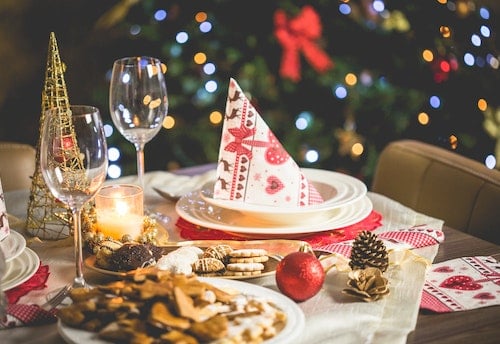How to Host a Traditional Polish Christmas Dinner
Christmas is a very important holiday in Poland. Every year, families get together to celebrate with music and dance, and of course, traditional dishes such as pierogi and kielbasa. If you’re a passionate Polish learner or you just love Polish culture, here is everything you need to know to host your own traditional Polish Christmas meal!
→Sign Up Now: Free Trial Polish Lesson With a Native Speaker Teacher!←
Do Poles eat meat on Christmas Eve?
No, Poles do not eat meat on Christmas Eve. In fact, most traditional Polish Christmas Eve dinners are completely vegetarian! This is because, in the past, people would fast for religious reasons and could not eat meat during this time. Nowadays, many Poles still choose to forego meat on Christmas Eve as a way to honour their traditions.
What are some traditional Polish Christmas Eve dishes?
Christmas Eve dinner is very important for Poles. It is a time when families and friends gather together to enjoy traditional Polish dishes and spend time with each other.

But before we delve into the most traditional Polish Christmas dishes, there are a couple of things you should bear in mind if you’re hosting a traditional Polish Christmas dinner.
- First of all, traditional Polish food is very hearty and filling. This is because Poles want to make sure that their guests are well-fed and comfortable. There are a lot of traditional dishes that are served at Polish Christmas meals, so it is important to have a variety of food options available.
- Another important thing to keep in mind when hosting a traditional Polish Christmas meal is that Poles love to drink. There will likely be some traditional Polish alcohol served at the meal, such as vodka or beer. It is important to make sure that there is enough alcohol for all of your guests, as Poles are known to enjoy a good drink (or two).
- Poles usually have 12 dishes during Christmas Eve dinner, which symbolize the 12 months of the year as well as the 12 apostles.
- Finally, traditional Polish dishes are definitely delicious, but they can also be a bit heavy.If you are not used to eating this type of food, it is important to pace yourself and not eat too much at once!
Now that we’ve got that out of the way, let’s take a look at some traditional Polish Christmas Eve dishes.
- Pierogi: These are dumplings that can be filled with a variety of different things, such as potato, cheese, or sauerkraut, which is a traditional Polish preparation made of fermented cabbage.
- Christmas Eve carp: This is a traditional Polish dish that is often served on Christmas Eve. The carp is usually fried or baked and served with horseradish and potatoes.
- Herring: This traditional Polish dish consists of pickled herring, often served with onion and potatoes.
- Christmas Eve red barszcz: This is a traditional beet soup that is made with red beets and often served with uszka (a type of small dumpling).
- Poppy seed cake (or Kutia): This is a traditional Polish cake that is often made with poppy seeds and honey.
What is the traditional way to celebrate Christmas in Poland?
Christmas in Poland is typically celebrated with a large dinner on Christmas Eve. After the meal, families will often exchange gifts and then attend Midnight Mass. On Christmas Day, a traditional breakfast is typically eaten, and then the family will spend the day together.

Is it true that Poles set an extra plate and seat for an unexpected guest?
Yes, it is traditional for Poles to set an extra place at the table and leave a seat open in case a stranger or someone in need comes by. This is seen as a way to welcome Christ into one’s home. So, if there is someone in your neighbourhood or among your group of friends who doesn’t have a family to celebrate Christmas with, consider inviting them to join your table!
Why is Christmas dinner known as Wigilia?
Wigilia is the traditional name for Christmas Eve dinner in Poland. It comes from the Latin word “vigil,” which means “to watch.” This is because in the past, people would stay up all night to attend Midnight Mass. Nowadays, Wigilia is still seen as a time to be with family and friends and to reflect on the past year.
The traditional way to decorate a Christmas tree
Christmas wouldn’t be Christmas without a nice tree to decorate and illuminate your home. In Poland, the traditional way to decorate a Christmas tree is with handmade or organic ornaments that symbolise important concepts.
Here are some traditional Polish Christmas tree decorations:
- Glass ornaments: These are often used to remind us of the beauty of nature.
- Fruit: Fruit is often used to represent the bounty of the earth.
- Nuts: Nuts are seen as a symbol of fertility.
- Pine cones: Pine cones stand for strength and endurance.
Is there a traditional Polish Christmas song?
Music is an essential part of a Polish Christmas celebration, as it adds a festive atmosphere and brings people together. In Poland, Christmas carols are often sung on Christmas Eve and also on Christmas Day.
For language lovers, these traditional songs are also a wonderful opportunity to learn or practise the Polish language. All you have to do is print the lyrics, hand over a copy to every member of your family, and encourage everyone to follow along!
According to a recent survey, the most popular carol in present-day Poland is Wśród Nocnej Ciszy (In the Silence of the Night).
Here is an extract of the lyrics, followed by a full sing-along video:
Wśród nocnej ciszy głos się rozchodzi:
In the silence of the night a voice radiates:
Wstańcie, pasterze, Bóg się wam rodzi!
Stand up, shepherds, God is born for you!
Czym prędzej się wybierajcie,
Go as quick as you can
Do Betlejem pospieszajcie
To Bethlehem you hurry
Przywitać Pana.
To greet the Lord.
Whether you want to honour your Polish ancestry or just do something different next Christmas, hosting a traditional Polish Christmas meal is an unforgettable experience that will teach you a lot about Polish values and culture.
With a little bit of planning and some traditional recipes, you can create a festive feast that your friends and family will remember for years to come!
→Sign Up Now: Free Trial Polish Lesson With a Native Speaker Teacher!←
If you would like to improve your Polish level by sharpening your speaking skills or learning a few essential Polish phrases for travellers, try one of our tailored one-to-one courses taught by native teachers. Our courses are flexible and can be tailor-made to your needs, so you can focus on the topics that are most important to you. Contact us today to find out more!
